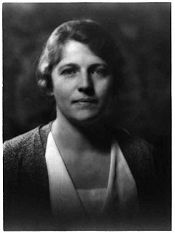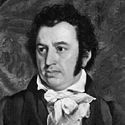Pearl S. Buck
| Pearl S. Buck | |
|---|---|
 Pearl Buck, ca. 1932. |
|
| Born | June 26, 1892 Hillsboro, West Virginia, United States |
| Died | March 6, 1973 (aged 80) Danby, Vermont, United States |
| Occupation | Writer |
| Nationality | American |
| Subjects | China |
| Notable award(s) | Pulitzer Prize 1932 Nobel Prize in Literature |
Pearl S. Buck (June 26, 1892 — March 6, 1973) also known as Sai Zhen Zhu (Simplified Chinese: 赛珍珠; Pinyin: Sài Zhēnzhū; Traditional Chinese: 賽珍珠), was a prolific American sinologist and Pulitzer Prize-winning American writer. In 1938, she became the first American woman to be awarded the Nobel Prize in Literature, "for her rich and truly epic descriptions of peasant life in China and for her biographical masterpieces." With no irony, she has been described in China as a Chinese writer.[1]
Contents |
Life
Pearl Comfort Sydenstricker Buck was born in Hillsboro, West Virginia to Caroline (Stulting; 1857-1921) and Absalom Sydenstricker, a Southern Presbyterian missionary. The family was sent to Zhenjiang, China in 1892 when Pearl was 3 months old. She was raised in China and was tutored by a Confucian scholar[2] named Mr. Kung.[3] She was taught English as a second language by her mother and tutor.
The Boxer Rebellion greatly affected Pearl Buck and her family. Buck wrote that during this time, …her eight-year-old childhood … split apart. Her Chinese friends deserted her and her family, and there were not as many Western visitors as there once were. The streets [of China] were alive with rumors- many … based on fact- of brutality to missionaries … Buck’s father was a missionary, so Buck’s mother, her little sister, and herself were …evacuated to the relative safety of Shanghai, where they spent nearly a year as refugees… (The Good Earth, Introduction) In July 1901, Buck and her family sailed to San Francisco. Not until the following year did the Sydenstrickers return to China.
In 1910, she left China once again for America to attend Randolph-Macon Woman's College [4], where she would earn her degree (Phi Beta Kappa) in 1914. She then returned to China and married an agricultural economist missionary, John Lossing Buck, on May 13, 1917. She lived with him in Suzhou, a small town in Southern China, very close to Shanghai. But this is not the region she described later as "The Good Earth."; her book was very much based on her experience in Anhui later. She served in China as a Presbyterian missionary from 1914 until 1933. Her views later became highly controversial in the Fundamentalist-Modernist Controversy, leading to her resignation as a missionary.
Part of a series on Protestant missions to China |
|
|---|---|
 |
|
| Robert Morrison | |
|
Background |
|
|
People |
|
|
Missionary agencies |
|
|
Impact |
|
|
Pivotal events |
|
|
Chinese Protestants |
|
In 1920, she and John had a daughter, Carol, who was afflicted with phenylketonuria. The small family then moved to Nanjing, where Pearl taught English literature at the University of Nanking. In 1925, the Bucks adopted Janice (later surnamed Walsh). In 1926, she left China and returned to the United States for a short time in order to earn her Masters degree from Cornell University.
From 1920 to 1933, Pearl and John made their home in Nanking (Nanjing), on the campus of Nanking University, where both had teaching positions. In 1921, Pearl's mother died, and shortly afterwards her father moved in with the Bucks. The tragedies and dislocations which Pearl suffered in the 1920s reached a climax in March 1927, in the violence known as the "Nanking Incident." In a confused battle involving elements of Chiang Kai-shek's Nationalist troops, Communist forces, and assorted warlords, several Westerners were murdered. The Bucks spent a terrified day in hiding, after which they were rescued by American gunboats. After a trip downriver to Shanghai, the Buck family sailed to Unzen, Japan, where they spent the following year. They later moved back to Nanking, though conditions remained dangerously unsettled.
Home
In 1935 Buck divorced her first husband and married her publisher and the president of John Day Company, Richard Walsh, with whom she moved to Pennsylvania. Buck bought a sixty-acre homestead she called Green Hills Farm in Bucks County, Pennsylvania. Green Hills Farm is where Buck spent thirty-eight years of her life, raising her family, writing, pursuing humanitarian interests, and gardening. She completed many works while living in Pennsylvania, such as This Proud Heart (1938), The Patriot (1939), Today and Forever (1941), and The Child Who Never Grew (1950).
Humanitarian efforts
Buck was an extremely passionate activist for human rights. In 1949, outraged that existing adoption services considered Asian and mixed-race children unadoptable, Pearl established Welcome House, Inc., the first international, interracial adoption agency. In the nearly five decades of its work, Welcome House has assisted in the placement of more than five thousand children. In 1964, to provide support for Asian-American children who were not eligible for adoption, Buck also established the Pearl S. Buck Foundation, which provides sponsorship funding for thousands of children in half a dozen Asian countries. When establishing the Opportunity House Foundation to support child sponsorship programs in Asia, Buck said, "The purpose...is to publicize and eliminate injustices and prejudices suffered by children, who, because of their birth, are not permitted to enjoy the educational, social, economic and civil privileges normally accorded to children." [5]
While the historic site works to preserve and display artifacts from her profoundly multicultural life, many of Buck's life experiences are also described in her novels, short stories, fiction, and children's stories. Through them she sought to prove to her readers that universality of mankind can exist if man accepts it. She dealt with many topics including women's rights, emotions (in general), Asian cultures, immigration, adoption, and conflicts that many people go through in life.
Pearl S. Buck died of lung cancer on March 6, 1973 in Danby, Vermont and was interred in Green Hills Farm in Perkasie. She designed her own tombstone, which does not record her name in English; instead, the grave marker is inscribed with Chinese characters representing the name Pearl Sydenstricker.[6]
Selected bibliography
Novels
- East Wind:West Wind (1930)
- The Good Earth (1931)
- Sons (1932)
- The Mother (1933)
- A House Divided (1935)
- The House of Earth (1935)
- Sons (1933)
- A House Divided (1935)
- This Proud Heart (1938)
- The Patriot (1939)
- Other Gods (1940)
- China Sky (1941)
- Dragon Seed (1942)
- The Promise (1943)
- The Townsman (1945) -- as John Sedges
- Portrait of a Marriage (1945)
- Pavilion of Women (1946)
- The Angry Wife (1947) -- as John Sedges
- Peony (1948)
- The Big Wave (1948)
- A Long Love (1949) -- as John Sedges
- God's Men (1951)
- The Hidden Flower (1952)
- Come, My Beloved (1953)
- Voices in the House (1953) -- as John Sedges
- Imperial Woman (1956)
- Letter from Peking (1957)
- Command the Morning (1959)
- Satan Never Sleeps (1962)
- The Living Reed (1963)
- Death in the Castle (1965)
- The Time Is Noon (1966)
- Matthew, Mark, Luke and John (1967)
- The New Year (1968)
- The Three Daughters of Madame Liang (1969)
- Mandala (1970)
- The Goddess Abides (1972)
- All Under Heaven (1973)
- The Rainbow (1974)
Biographies
- The Exile (1936)
- Fighting Angel (1936)
Autobiographies
- My Several Worlds (1954)
- A Bridge For Passing (1962)
Non-fiction
- Of Men and Women (1941)
- How It Happens: Talk about the German People, 1914-1933, with Erna Pustau (1947)
- The Child Who Never Grew (1950)
- My Several Worlds (1954)
- For Spacious Skies (1966)
- The People of Japan (1966)
- The Kennedy Women (1970)
- China as I See It (1970)
- The Story Bible (1971)
- Pearl S. Buck's Oriental Cookbook (1972)
Short Stories
- The First Wife and Other Stories (1933)
- Today and Forever: Stories of China (1941)
- Twenty-Seven Stories (1943)
- Far and Near: Stories of Japan, China, and America (1949)
- Fourteen Stories (1961)
- Hearts Come Home and Other Stories (1962)
- Stories of China (1964)
- Escape at Midnight and Other Stories (1964)
- The Good Deed and Other Stories of Asia, Past and Present (1969)
- Once Upon a Christmas (1972)
- East and West Stories (1975)
- Secrets of the Heart: Stories (1976)
- The Lovers and Other Stories (1977)
- Mrs. Stoner and the Sea and Other Stories (1978)
- The Woman Who Was Changed and Other Stories (1979)
- The Good Deed (1969)
Awards
- Pulitzer Prize for the Novel: The Good Earth (1932)
- William Dean Howells Medal (1935)
- Nobel Prize in Literature (1938)
References
- Peter J. Conn, Pearl S. Buck: A Cultural Biography (Cambridge; New York: Cambridge University Press, 1996)
- Elizabeth Johnston Lipscomb, Frances E. Webb Peter J. Conn, eds., The Several Worlds of Pearl S. Buck: Essays Presented at a Centennial Symposium, Randolph-Macon Woman's College, March 26-28, 1992 (Westport, CT: Greenwood Press, 1994)
- Liao Kang, Pearl S. Buck: A Cultural Bridge across the Pacific (Westport, CT, London: Greenwood Press, 1997)
- Karen J. Leong, The China Mystique: Pearl S. Buck, Anna May Wong, Mayling Soong, and the Transformation of American Orientalism (Berkeley: University of California Press, 2005)
- Pearl Buck's Portrait of Her Fighting Missionary Father (NY Times, November 29, 1936.)
Notes
- ↑ Meyers, Mike. "Pearl of the Orient," New York Times. March 5, 2006.
- ↑ Pearl Buck biography
- ↑ Biography, University of Pennsylvania
- ↑ Randolph-Macon Woman's College
- ↑ Pearl S. Buck International: Our History
- ↑ Conn, Peter. Dragon and the Pearl
External links
- Pearl S. Buck International Website
- The Pearl S. Buck Foundation, Taipei, Taiwan (Republic of China)
- Official Nobel Prize Website: Brief Biography
- Historic House and Museum (1892) at Pearl S. Buck's Birthplace in Hillsboro, WV
- University of Pennsylvania website dedicated to Pearl S. Buck
- Brief biography
- Brief biography at Kirjasto (Pegasos)
- Buck at IMDb
- National Trust for Historic Preservation on the Pearl S. Buck House Restoration
- Pearl S. Buck burial information from FindAGrave.com
- Finding Aid for the Pearl S. Buck Letter, 1943 The University of North Carolina at Greensboro.
|
||||||||